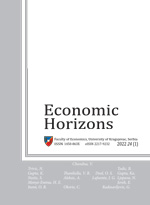IMPLICATIONS OF THE APPLICATION OF DOLLARIZATION FOR MACROECONOMIC STABILITY
Vesna Martin
National bank of Serbia, Financial Stability Department, The Republic of Serbia
The aim of this paper is to present the costs and benefits of applying dollarization. The most common reason for accepting, in whole or in part, a foreign currency is the presence of a high and volatile inflation rate, which is followed by the significant volatility of the exchange rate, as well as a distorted confidence in its own currency. Likewise, highly dollarized countries most often characterized by a lower level of the development of the financial market. Dollarization contributes to lowering the costs of transactions in international trade and to achieving the price and financial stability, as import inflation is lower than domestic. On the other hand, the presence of full dollarization means a loss of seigniorage as the monetary authorities’ revenue from the printing of money, as well as the limitation of the implementation of the lender’s function in the last instance. The results of the analysis indicate that, in the dollarized countries, there was a decrease in the inflation rate, macroeconomic stability was established, and financial integration was present as well. The analysis also showed that the loss of income from seigniorage, measured as a share in the gross domestic product, is not negligible, while the lender’s function in the latter instance can be compensated through the formation of stabilization funds and the conclusion of contracts with financial institutions.
Keywords: dollarization, lender of last resort, seigniorage, integration of financial markets
JEL Classification: E42, E44, E58




